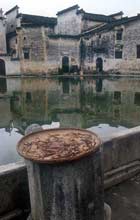
 From 1120 in the Northern Song dynasty to the fall of the Qing dynasty in 1911, Huangshan was located in what was known as the Huizhou prefecture.
From 1120 in the Northern Song dynasty to the fall of the Qing dynasty in 1911, Huangshan was located in what was known as the Huizhou prefecture.
Devotees of the "The Romance of the Three Kingdoms", a Chinese historical fiction that describes the warring period from 220-280 A.D., will be thrilled to learn that a former residence of General Caocao is located in Huizhou, and that near to it, nine Cao family tombs have been discovered.
Notwithstanding this third century claim to fame, it was not until the middle of the Southern Song dynasty (1127 – 1279) that Huizhou took up a national position that it was to expand over the next 600 years. Under Emperor Gao Zong (r. 1127 – 1187), the Imperial court plumbed new levels of decadence. It reacted to the threat of a Jurchen invasion by relocating the Imperial capital to Hangzhou and initiating an extensive public works program. When the Imperial court arrived at its new capital in 1132, Huizhou merchants were on hand to supply bamboo, wood, lacquer and craftsmen for the construction of palaces, pavilions, villas and temples.
This construction boom provided Huizhou traders with capital to branch out into new industries and provinces. It transpired that with the strengthening of the southern economy, Huizhou's location between Zhejiang and Jiangsu provinces could be made to turn a profit. Soon Huizhou had become a key communications and trade route; local traders diversified into selling tea, grain, silk, cloth, paint, pottery, ink and paper. Commerce, frowned upon in Confucian ethics, became such a boon to this hitherto marginalized area that during Emperor Jiajing's reign (r. 1522 – 1567), some 70% of Huizhou's population was involved in it.
However, it was when Huizhou's merchants turned to the high margin salt and pawnbroking businesses that they were able to accelerate their expansion. They thus spread to all corners of China and even expanded into some Southeast Asian countries. Indeed, it was said that by the reign of Emperor Guangxi (1875 – 1909) all pawnbrokers were from Huizhou.
By investing in Huizhou's education they were able to field many candidates for Imperial Examinations and thus influence the Imperial bureaucracy. Between 960 – 1911 as many as 2,018 people from Huizhou achieved the highest level in Imperial government. In this way, these artful traders conspired to maintain such commercial advantages as their valuable salt monopolies.
Having gained fame and fortune, Huizhou merchants returned to their homeland to invest their gains in large-scale construction. To increase their personal prestige, to honor their ancestors and to strengthen their clan they built ancestral halls, mansions, memorial arches and bridges; all the architectural splendor that still decorate Huizhou's magnificent land.